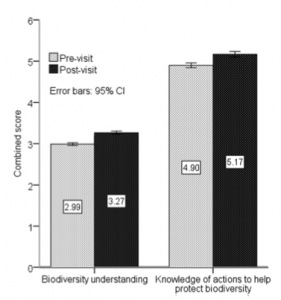The Zoo Debate: Educators or Entertainers?
Evidence for the Positive Contributions of Zoos and Aquariums to Aichi Biodiversity Target 1
By Emily Rose Nelson, RJD Intern
The UN Strategic Plan for Biodiversity 2011-2020, adopted by the Convention on Biological Diversity in 2010, is a ten-year model aiming to protect biodiversity and the benefits it provides. The plan is essential in global efforts to halt and, optimistically, reverse the current loss of biodiversity. 20 target goals, known as the Aichi Biodiversity Targets, have been put in place with intent to increase value people put on biodiversity, maintain ecosystem services and support global action for a healthy planet. The first of these targets is as follows, “ by 2020, at the latest, people are aware of the values of biodiversity and the steps they can take to conserve and use it sustainably.” Achieving such an ambitious goal as this will not be possible without work from zoos and aquariums.
Annually zoos and aquariums around the world receive over 700 million visitors (Gusset and Dick, 2011) providing them with the potential to make a huge impact in achieving Aichi Target 1. A 2007 study found that 131 out of 136 zoo mission statements reference education and 118 out 136 specifically mention conservation (Patrick et al, 2007). However, many of these institutions market themselves for entertainment and weaken messages of environmental education.
Moss and collaborators (2014) set out to evaluate the educational impacts of zoos and aquariums. 5,661 visitors to 26 zoos in 19 different countries all over the world were given the same open-ended surveys before and after their visit. Participants were asked to list up to five things that came to mind when they thought about biodiversity and list two actions they could take to help save animal species. Content analysis was used to provide quantitative data from these responses.
Results of the study showed that understanding of biodiversity and knowledge of actions to help protect biodiversity both significantly increased over the course of zoo and aquarium visits, providing evidence that zoos and aquariums are largely serving their role as educators as well as entertainers. The outcome shown by Moss et. al calls attention to the importance of zoos and aquariums in achieving Aichi Target 1.

Both dependent variables, biodiversity understanding and knowledge of actions to protect biodiversity, show significant difference between surveys before and after visiting a zoo or aquarium.
However, an increase in knowledge regarding biodiversity is not necessarily an indicator of a related change in behavior to protect biodiversity. Zoos and aquariums face the challenging task of moving people to action. One way in which they are already doing this is providing people with a connection to nature. If one feels attached to something they are more likely to care about its conservation (Falk et al, 2007). Additionally, zoos and aquariums can play a part in pro-conservation action by advocating for policy changes that protect land and wildlife, targeting and providing alternatives to threatening social norms, and serving as a role model for their visitors and other institutions.
Works Cited:
Falk, J. H., E. M. Reinhard, C. L. Vernon, K. Bronnenkant, N. L. Deans, and J. E. Heimlich. 2007. Why zoos and aquariums matter: assessing the impact of a visit to a zoo or aquarium. Association of Zoos & Aquariums, Silver Spring, MD.
Gusset, M., and G. Dick. 2011. The global reach of zoos and aquariums in visitor numbers and conservation expenditures. Zoo Biology 30:566–569.
Moss, Andrew, Eric Jensen, and Markus Gusset. “Evaluating the Contribution of Zoos and Aquariums to Aichi Biodiversity Target 1.” Conservation Biology (2014).
Patrick, P. G., C. E. Matthews, D. F. Ayers, and S. D. Tunnicliffe. 2007. Conservation and education: prominent themes in zoo mission statements. Journal of Environmental Education 38:53–60.





Leave a Reply
Want to join the discussion?Feel free to contribute!